Host cell species-specific effect of cyclosporine A on simian immunodeficiency virus replication
- PMID: 22225545
- PMCID: PMC3311600
- DOI: 10.1186/1742-4690-9-3
Host cell species-specific effect of cyclosporine A on simian immunodeficiency virus replication
Abstract
Background: An understanding of host cell factors that affect viral replication contributes to elucidation of the mechanism for determination of viral tropism. Cyclophilin A (CypA), a peptidyl-prolyl cis-trans isomerase (PPIase), is a host factor essential for efficient replication of human immunodeficiency virus type 1 (HIV-1) in human cells. However, the role of cyclophilins in simian immunodeficiency virus (SIV) replication has not been determined. In the present study, we examined the effect of cyclosporine A (CsA), a PPIase inhibitor, on SIV replication.
Results: SIV replication in human CEM-SS T cells was not inhibited but rather enhanced by treatment with CsA, which inhibited HIV-1 replication. CsA treatment of target human cells enhanced an early step of SIV replication. CypA overexpression enhanced the early phase of HIV-1 but not SIV replication, while CypA knock-down resulted in suppression of HIV-1 but not SIV replication in CEM-SS cells, partially explaining different sensitivities of HIV-1 and SIV replication to CsA treatment. In contrast, CsA treatment inhibited SIV replication in macaque T cells; CsA treatment of either virus producer or target cells resulted in suppression of SIV replication. SIV infection was enhanced by CypA overexpression in macaque target cells.
Conclusions: CsA treatment enhanced SIV replication in human T cells but abrogated SIV replication in macaque T cells, implying a host cell species-specific effect of CsA on SIV replication. Further analyses indicated a positive effect of CypA on SIV infection into macaque but not into human T cells. These results suggest possible contribution of CypA to the determination of SIV tropism.
Figures
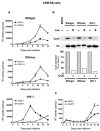
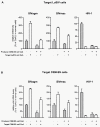
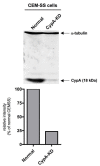
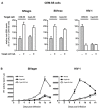

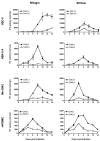
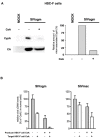

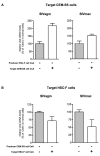
Similar articles
-
Contribution of Cyclophilin A to determination of simian immunodeficiency virus tropism: a progress update.Vaccine. 2010 May 26;28 Suppl 2:B51-4. doi: 10.1016/j.vaccine.2009.10.020. Vaccine. 2010. PMID: 20510744
-
Tissue-specific restriction of cyclophilin A-independent HIV-1- and SIV-derived lentiviral vectors.Gene Ther. 2008 Aug;15(15):1079-89. doi: 10.1038/gt.2008.50. Epub 2008 Apr 3. Gene Ther. 2008. PMID: 18385767
-
Transfer of the HIV-1 cyclophilin-binding site to simian immunodeficiency virus from Macaca mulatta can confer both cyclosporin sensitivity and cyclosporin dependence.Proc Natl Acad Sci U S A. 1997 Sep 30;94(20):10943-8. doi: 10.1073/pnas.94.20.10943. Proc Natl Acad Sci U S A. 1997. PMID: 9380739 Free PMC article.
-
Cyclophilin A: A Key Factor in Virus Replication and Potential Target for Anti-viral Therapy.Curr Issues Mol Biol. 2017;21:1-20. doi: 10.21775/cimb.021.001. Epub 2016 Mar 31. Curr Issues Mol Biol. 2017. PMID: 27033630 Review.
-
An SIV/macaque model targeted to study HIV-associated neurocognitive disorders.J Neurovirol. 2018 Apr;24(2):204-212. doi: 10.1007/s13365-017-0582-4. Epub 2017 Oct 3. J Neurovirol. 2018. PMID: 28975505 Free PMC article. Review.
Cited by
-
Broadly Neutralizing Human Immunodeficiency Virus Type 1 Antibody Gene Transfer Protects Nonhuman Primates from Mucosal Simian-Human Immunodeficiency Virus Infection.J Virol. 2015 Aug;89(16):8334-45. doi: 10.1128/JVI.00908-15. J Virol. 2015. PMID: 26041300 Free PMC article.
-
SIV replication in human cells.Front Microbiol. 2012 Apr 27;3:162. doi: 10.3389/fmicb.2012.00162. eCollection 2012. Front Microbiol. 2012. PMID: 22679440 Free PMC article.
-
Heterogeneous susceptibility of circulating SIV isolate capsids to HIV-interacting factors.Retrovirology. 2013 Jul 24;10:77. doi: 10.1186/1742-4690-10-77. Retrovirology. 2013. PMID: 23883001 Free PMC article.
-
Functional constraints on HIV-1 capsid: their impacts on the viral immune escape potency.Front Microbiol. 2012 Oct 17;3:369. doi: 10.3389/fmicb.2012.00369. eCollection 2012. Front Microbiol. 2012. PMID: 23087682 Free PMC article.
-
N-terminally truncated POM121C inhibits HIV-1 replication.PLoS One. 2017 Sep 5;12(9):e0182434. doi: 10.1371/journal.pone.0182434. eCollection 2017. PLoS One. 2017. PMID: 28873410 Free PMC article.
References
Publication types
MeSH terms
Substances
LinkOut - more resources
Full Text Sources
Other Literature Sources

